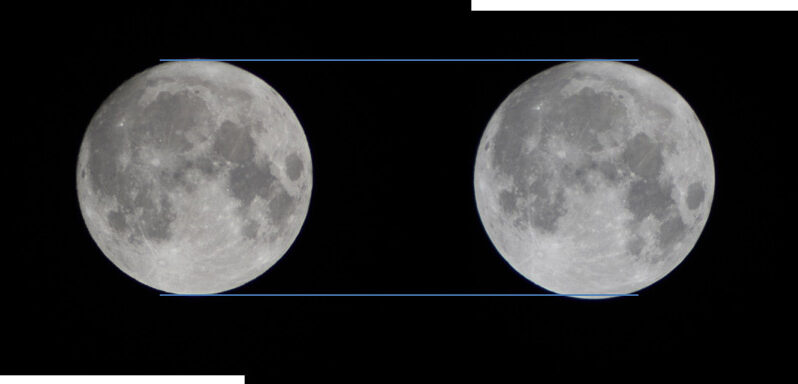
The visual difference between a regular full moon and a supermoon. Credit: NASA
The coming months will bring a whopping 4 full Supermoons, leading to what we like to call a Supermoon season. Read on to learn what a Supermoon is, when these upcoming Supermoons will occur, and how you can view them from your backyard.
What is a Supermoon?
The Moon’s orbit around the Earth isn’t a perfect circle — it’s elliptical, meaning that the Moon moves closer and further away from the Earth throughout the path of its orbit. The term “Supermoon” describes any full Moon that occurs within 10% of its closest distance to Earth.

Credit: NASA/JPL-Caltech
The technical term for a Supermoon is “perigee-syzygy of the Earth-Moon-Sun system.” Perigee occurs when the Moon comes closest to Earth in its slightly elliptical orbit around the Earth, and syzygy occurs when three or more celestial bodies are aligned in a straight line. Whenever the Earth, Moon, and Sun line up, it is either a new moon or a full moon. The full Moon version of syzygy is also called “opposition” because the Moon is directly opposite the Sun as viewed from Earth.

Credit: NASA/JPL-Caltech
Supermoon Dates
July 3, 2023: Super Buck Moon
The first of four Supermoons this summer has actually already occurred. Even if you missed it, you may have noticed that the last full Moon seemed a little bigger and brighter than usual. July’s full Moon is called a Buck Moon by some Native American tribes because it marks the time of the year that male deer begin to grow new horns after shedding their old ones.
August 1, 2023: Super Sturgeon Moon
North American fishing tribes called August’s full Moon the Sturgeon Moon since the species tends to appear in large numbers during this month. It’s also been called the Green Corn Moon, the Grain Moon, and the Red Moon for the reddish color it can sometimes take on in the summer haze.
August 31, 2023: Super Blue Sturgeon Moon
The month of August will bring not one, but two Super Sturgeon Moons! According to NASA, the traditional definition of a Blue Moon refers to the 3rd full Moon in a season that has 4 full Moons. The second common definition was the result of a misunderstanding, and claims that a Blue Moon is the second of 2 full moons that occur within the same month. In the case of this full Moon, it’s a Blue Moon by both definitions!
September 29, 2023: Super Corn Moon
September’s Moon is referred to as the Corn Moon, since it corresponds with the time to harvest corn in much of the northern United States. A number of Native American peoples traditionally used some variation of “Corn Moon” to refer to the Moon of August or September. This Corn Moon will be the last Supermoon of the season.
How to View a Supermoon
Luckily, viewing a Supermoon is much easier than viewing smaller or more obscure objects in the night sky. To admire one, all you need to do is look up once the Moon rises in the sky! For the most spectacular show, we recommend starting your viewing session just after sunset so you can watch the Supermoon rise over the horizon. Telescope and binocular viewers will be able to see even more detail on the lunar surface than usual, so be sure to take advantage of the Moon’s close proximity and brightness over the course of the next few months!